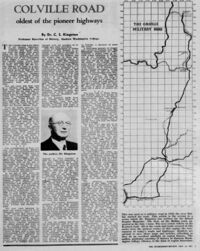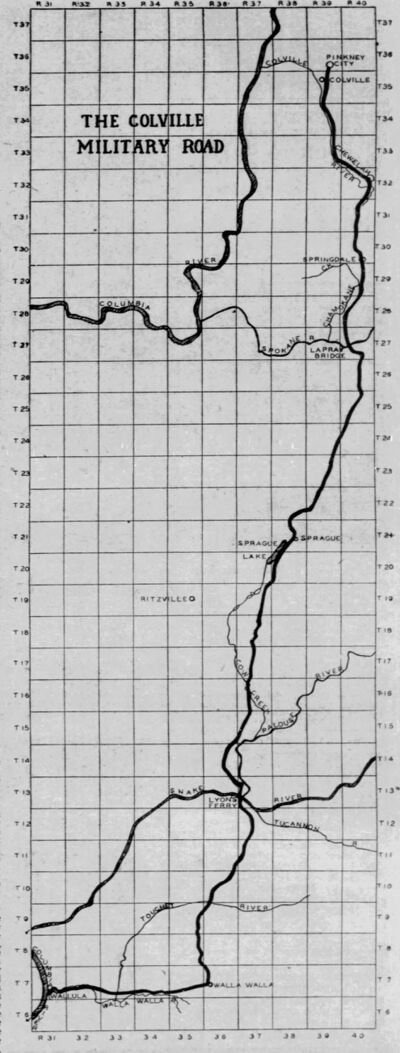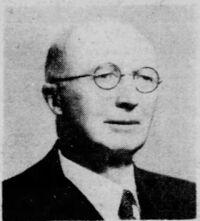Colville Road
From the Spokesman-Review 15 July 1951 page 59:
COLVILLE ROAD--oldest of the pioneer highways
By Dr. C. S. Kingston Professor Emeritus of History, Eastern Washington College.
This was in the The Colville road is the oldest of the pioneer highways; Indians, explorers and missionaries had made their way from the Snake river north along the old trails west of the Palouse to the Spokane and then on by the way of the Chamokane Creek valley, a natural route to the Colville valley, which leads on to the Columbia river at Kettle Falls. Not only did the terrain indicate the route in a general way, but it seemed to fit into the travel needs of both the Indians and the whites. There were some variations; the Spokane House traders followed an Indian trail on the north bank of the Spokane river to reach the Colville trailsa route which David Thompson went over several times.
This old route was first used as a military road in 1859, the same year that Mullan's work was started but the road that he planned in that year was abandoned when it was found that it would be impracticable to go around Lake Coeur d'Alene on the south side and it was not until 1860 that work was undertaken along the route which became the historic Mullan Road.
From the Snake river to Cow creek, a distance of 25 miles, the Colville and the Mullan roads were identical, but here they diverged. The Mullan road turned northeastward to the Spokane river where Antoine Plante's ferry furnished a crossing, while the Colville road went on to the north past Sprague lake, which David Thompson saw in 1811. From here the road passed through southeastern Lincoln and northwestern Spokane counties. After leaving Rock creek and Willow springs, a well-known camping place, it ran about 5 miles west of Deep creek in section 29. Twp. 25 N., R. 40 EWM [just west of the West Deep Creek Grange Hall], crossed Coulee creek at the forks and on to the "Winding Ford" in the Spokane River.
The establishment of Fort Colville and the Colville Military road were both developments that grew out of the Indian wars of 1855-58. Although the Indians of north Washington had not taken part before 1858 in the hostilities that began in 1855. their sympathies were on the side of the hostiles, as they keenly realized that the coming of large numbers of settlers endangered the way of life they had followed for uncounted generations.
In the fall of 1857, when the white population of the Colville valley was not more than 250, the increasing unfriendliness of the Indians brought about the organization of a voluntary local government and petitions asking for the location of a company of soldiers for the protection of the people in the valley were sent to the military authorities. In May, 1858, Lt. Col. Steptoe, commandant at Fort Walla Walla, decided to examine the situation in the region north of the Snake: but he was stopped and defeated in an engagement near Rosalia by a combined force of Spokane. Coeur d'Alene and Palouse Indians.
The next clash between Indians and whites occurred in the Okanogan country when a party of 167 miners and packers on their way to the Fraser river gold diggings were stopped at McLoughlin canyon by the Indians, and three white men were killed. The party. however, outflanked the Indian position and went on to the mining country north of the international border. Then in September of the same year, 1858, Colonel Wright, with a large and well-equipped force, invaded the Spokane country, defeated the Indians in open field .engagements, destroyed their herds of horses. took hostages, and hung a number of Indians who were charged with the murders of civilians and other atrocities.
After the suppression of Indian resistance it was decided to establish army posts in strategic locations to maintain peaceful relations between the Indians and the whites. One of these locations was the Colville valley. In the spring of 1859 Maj. Pinkney Lougenbeel, with two companies of infantry, marched from Walla Walla to the Colville valley and constructed the buildings for a four-company army post on Mill creek about three miles from the present city of Colville. This was called Fort Colville, U. S. A., and is not to be confused with Fort Colville of the Hudson's Bay company, which was on the Columbia. river some 15 miles distant. During the winter of 1859- 60 two more companies of soldiers that had been detailed to protect the engineers of the Boundary commission were also quartered at Fort Colville, together with the Boundary commission engineers.
A few hundred yards from Fort Colville there grew up a little satellite town that was known as Pinkney City or Pinkneyville, from the first name of Major Longenbeel. The name was The author, Dr. Kingston. changed to "Fort Colville" in 1868, but there was something in the name "Pinkney City" that has kept it alive to the present day, although there is nothing there today--hardly a wide spot in the road--to remind the passer-by that here was once the county seat of old Spokane county when in the early 1860s it extended from the Columbia river to the Rocky mountains.
A correspondent of the Pacific Tribune (Olympia) of July 8. 1865, stated that about 60 families were living in the valley at that time. Of the town he wrote: "Pinkney City, the county seat, located on a tributary of the Colville, deserves a passing notice. The town contains 15 or 20 houses. three stores, one saloon, brewery and a blacksmith shop. Churches and schools have not yet come into fashion...
...The present permanent population of the place consists of about 10 whites, 10 Indians, the same number of Chinamen and from 75 to 100 Cayuse horses. During winter, however, it is usually the headquarters of quite a mining population from the Kootenai and Columbia, at which time it is said to be very lively..."
It was the trading center for the northeastern part of the territory and its merchants supplied the needs of both the settlers and the soldiers at the post. Goods sold here were bought from wholesale dealers, brought up the Columbia in river steamboats, unloaded at Wallula, the river port of Walla Walla, and then carried on wagons--sometimes on pack mules--all the way to Colville, a distance of some 250 miles.
A surprising amount of freight was carried to Pinkney City. The Statesman (September 23. 1864) mentions a wagon train of six-mule teams belonging to Ferguson & Co. bringing in 50,000 pounds of merchandise, and that this was one of six trips during the season. The Colville settlement was far away and isolated; consequently, transportation costs were heavy. W. P. Winans, one of the Colville merchants, records paying $1950 in 1863 on 13,000 pounds of merchandise from Wallula to Colville. This averages 15 cents a pound. In 1856 he states that he paid 124 cents a pound, or $250 a ton from Wallula to Colville and sold coffee at 75 cents a pound, sugar 50 cents, salt 25 cents, nails 40 cents, shot 50 cents, a spool of thread 25 cents and a paper of needles the same.
The long road to Walla Walla and Wallula was now known as the Colville Military road. Where improvements were necessary, soldiers were detailed for the work; but the crossing of the Spokane river was left to private enterprise. When the river was low the old "winding ford" provided a means, of crossing; but now, with the military establishment and the increasing growth of civilian population in the valley, a more dependable link in the line of communications was necessary. This meant, first, a regular ferry and later the building of a bridge.
The first ferry was put in by J. R. Bates in 1859 and ferry service was maintained by a succession of owners until 1867, when a toll bridge was completed. Authorization for this bridge had been granted by the territorial assembly to William Nix and James Monaghan in an act dated January 11, 1866. The property was sold, according to W. P. Winana, about 1875, to Joseph Lapray. who operated the bridge for many years. The site is now covered by the backwater from the Long Lake dam [just about directly north of the Crescent Grade].
In the 1860s and 1870s the Colville military road from Walla Walla and Wallula continued to be the principal means by which the Colville valley and Fort Colville were supplied with merchandise and military requirements from the outside world. Some freight was hauled from White Bluffs, but most of the freight wagons were operated by men who had their homes either in the Colville valley or in the Walla Walla country, and they preferred the older route across the Snake river and thence northward.
The situation altogether changed in the 1880s with the building of the Northern Pacific railroad. The line reached Spokane Falls from the west in 1881, and this point now became the supply center for northeastern Washington. In that same year the old road from Cottonwood Creek south of Chewelah, which had been cut through the woods in 1867 by the inhabitants of the Colville valley to reach Spokane bridge was improved with some changes by detachments of the men from the fort, under the command of Captain Hunter, with John Helstetter as overseer who had laid out the original 14 years before. From Spokane Falls this road was shorter by several miles than the old military road by way of the La Pray bridge and Walker's Prairie.
Consequently, most of the freight and travel now crossed the Little Spokane by a bridge south of Chattaroy and then on past Loon lake on the height of land between the Spokane and Colville river drainage systems. This continued to be the freighting road until D. C. Corbin's Spokane Falls and Northern railroad was completed in 1889.
This article is the second in a series which Dr. Kingston has written for the Inland Empire Magazine. The first, on the Mullan road, appeared in the July 1 issue. The next article will be on the Kentuck trail. All of the roads and trails covered in this series were the pioneer routes of this region, the forerunners of today's roads and highways. Readers are advised to save these maps and articles, affording as they do an excellent sidelight on region history.


